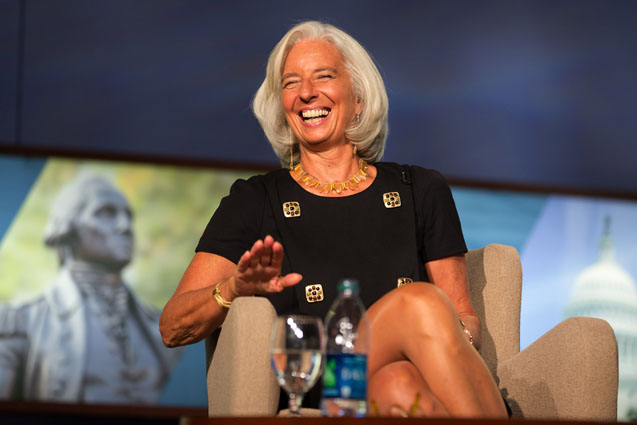Personal Wealth Management /
Brewing Yet Another Debt Ceiling Debate
Is the debt ceiling a global economic issue?
You’d think IMF Managing Director Christine Lagarde would be blushing over mistaken understanding of the term “default.” Photo by Getty Images News.
Of all the things the US’s budget bickering supposedly impacts, I’ve seen exactly one with substance: Craft beer. It seems the good folks who approve new brew are on furlough, delaying license applications for all new breweries and this winter’s seasonal beer. Only a small bite out of the economy, perhaps, but a bite nonetheless—and a bigger bite out of life enjoyment for those who love a tall one. Beyond that, however, the fallout still seems minimal. A long shutdown or debt ceiling delay (effectively one in the same, as Todd Bliman pointed out) won’t much hurt US auto sales. Or Korean exports. Or Puerto Rico. Or France. Or Europe. Or, despite what the IMF warned last week, the world. Maybe goats, but they’ll survive. So will the US economy, Treasury markets and stocks.
So why do the IMF and many world leaders insist on framing the debt ceiling as a global economic issue?
Perhaps they misperceive the definition and risk of default if Congress delays. I suppose I can pardon this—only super-nerds like your friendly MarketMinder writers would bother digging up the 1985 Government Accountability Office memo permitting the US Treasury to prioritize interest payments or the 1935 Supreme Court decision interpreting the 14th Amendment as a constitutional requirement to do so. Maybe leaders just don’t have time to research how Federal law applies to bonded US debt. It’s ok. They’re busy trying to run the world and stuff. Then again, presumably the IMF, after overseeing two Greek defaults last year, would understand the finer technical distinctions of a sovereign default. But no matter—wires get crossed.
But it seems a more philosophical issue is also at work. Even if the US keeps paying its debts, some global bigwigs fear the economic impact of big public spending cuts—doubly if these cuts are married with the tapering of the Fed’s quantitative easing (QE). It points to a misunderstanding (in my view) of what drives growth. The notion the US economy can’t stand without heavy government or Fed contributions is flawed—public spending and QE funny money aren’t the US’s economic fuel. The US’s main economic engine is its robust private sector. For businesses, fuel for growth is free-flowing capital—the more resources go their way, the faster they’ll grow and the more they’ll hire. Which you’d think the IMF would believe considering its history is loaded with sweeping fiscal contraction mandates delivered to a huge swath of the world economy, but I digress.
QE isn’t stimulus—it keeps money from moving as freely as it should be. By purchasing long-term assets, the Fed flattened the spread between short- and long-term interest rates—banks’ net interest margin and key source of operating profits, sapping their incentive to lend. Hence, broad money aggregates are anemic and loan growth the weakest of the past five expansions—and since businesses haven’t gotten the capital they need for growth-oriented spending, headline growth isn’t robust. Ending QE should be an economic windfall—the yield spread will widen, money should circulate faster, and businesses should finally unleash all that pent up investment. Since advanced and emerging economies’ interest rates are typically highly correlated, spreads should widen globally, too—global stimulus!
Most of the world sees QE backward, and I have a hunch they see the public spending issue backward, too. If the government goes a long time without the ability to fund its many, many programs, it might not be so bad for the US economy as feared. I’m not talking about Social Security, Medicare, Medicaid and Federal unemployment benefits—tax revenue covers all that plus debt interest with about $600 billion left over. I’m talking about the agencies and programs competing for that other $600 billion. If they stay shut, the resources they use and the services they provide will have to shift to the private sector, which has proven to spend a touch more productively than the government—logical when you remember private firms are driven by economic good sense, not political interests. Sure, money spent by the government eventually goes to productive use, but often it takes a few extra spends—private firms would probably skip spending on high-speed railroad tracks in far-flung rural regions and go straight to buying new equipment from innovative producers. Or investing in development of productive new technology.
Not that a prolonged shutdown or debt ceiling delay would be wonderful or even desired! Just not the catastrophe widely feared. It rather recalls the sequester—those automatic spending cuts that kicked in on March 1. Then, headlines globally warned of the economic fallout of significantly less public spending. And spending did fall—but the economy grew at roughly the same rate it did pre-sequester. Just as GDP has continually hit new highs despite government spending detracting from growth in 12 of the past 16 quarters.
The reason why it keeps growing is the same reason why stocks keep rising: Private businesses are strong. So strong, they’re finding ways to invest and grow even while the Fed keeps monkeying with QE. Revenues are strong and profits are high—$1.7 trillion as of Q2, allowing firms to invest without spending down cash balances. Business investment hit $1.97 trillion in Q2, closing in on all-time highs, yet non-financial corporate balance sheets still held $1.8 trillion—fodder for future investment, share buybacks, cash-based M&A and other growth-oriented spending. All of which boosts future earnings potential—and, by extension, future stock prices. When contractionary QE ends and money finally starts moving, the future looks even better.
Investors, like the IMF, World Bank and seemingly half the world, see this backward. Great! False fears are bullish—and false fears as big as today’s bring massive positive surprise power. As this saga plays out and investors gradually realize just how much reality trumps fear, they’ll have many reasons to bid shares higher.
If you would like to contact the editors responsible for this article, please message MarketMinder directly.
*The content contained in this article represents only the opinions and viewpoints of the Fisher Investments editorial staff.
Get a weekly roundup of our market insights
Sign up for our weekly e-mail newsletter.

You Imagine Your Future. We Help You Get There.
Are you ready to start your journey to a better financial future?

Where Might the Market Go Next?
Confidently tackle the market’s ups and downs with independent research and analysis that tells you where we think stocks are headed—and why.






